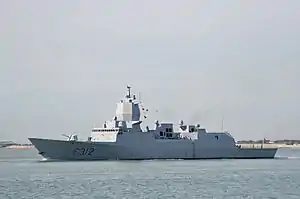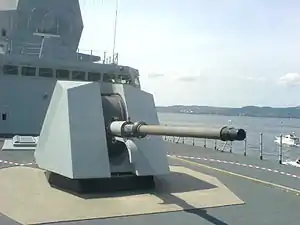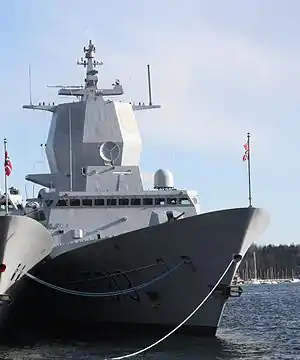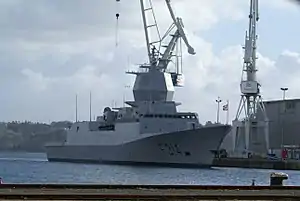Fridtjof Nansen-class frigate
The Fridtjof Nansen-class frigates are a class of frigates that are the main surface combatant units of the Royal Norwegian Navy. The ships are named after famous Norwegian explorers, with the lead ship of the class bearing the name of Fridtjof Nansen, the Norwegian scientist, explorer and humanitarian. Five ships were ordered from Spanish shipbuilder Bazan (now Navantia). The total projected cost for all five ships is 21 billion kr (about USD 2.39 billion).[1] As of November 2018, four are in active service and one has sunk and been decommissioned.
 | |
| Class overview | |
|---|---|
| Name: | Fridtjof Nansen class |
| Builders: | Navantia, Ferrol, Spain |
| Operators: |
|
| Preceded by: | Oslo class |
| Cost: | |
| Completed: | 5 |
| Active: | 4 |
| Lost: | 1 |
| General characteristics | |
| Type: | Multi-role frigate |
| Displacement: | 5,290 tons full load |
| Length: | 134 m (440 ft) |
| Beam: | 16.8 m (55 ft) |
| Draft: | 4.6 m (15 ft) |
| Propulsion: |
|
| Speed: | 27 knots (50 km/h; 31 mph)+ |
| Range: | 4.500 nmi (8.334 km; 5.179 mi) at 16 knots (30 km/h; 18 mph) |
| Complement: | 120, accommodations for 146 |
| Sensors and processing systems: |
|
| Electronic warfare & decoys: |
|
| Armament: |
|
| Aircraft carried: | 1 × NHIndustries NH90 helicopter |
Design
The frigates were originally intended as a replacement for the aging Oslo-class frigates, with a primary focus on anti-submarine warfare (ASW). Eventually, the need for a robust anti-aircraft defense as well as the possibility of incorporating the Naval Strike Missile surface-to-surface missile produced by Norwegian company Kongsberg Defence & Aerospace led to a more multi-role design. The selection of Navantia as prime contractor led to the design being very similar to the Spanish Navy's Álvaro de Bazán-class frigates, including the incorporation of Lockheed Martin's AEGIS combat system.
Improvements
The Fridtjof Nansen-class frigates are larger, and have more personnel and equipment than the Oslo-class frigates. Compared to the Oslo-class vessels, the new vessels are 35 meters longer, nine meters taller and two meters deeper below water. They are also five meters broader and have three times the water displacement of the old ships. The frigates also operates six new NFH NH90 helicopters, with the role as an extended "arm" of the frigates' ASW and ASuW capabilities.
Service history
On 26 February 2009, the Norwegian government decided to deploy Fridtjof Nansen to the Gulf of Aden, thereby participating in the ongoing Operation Atalanta, the European Union's counter-piracy campaign in Somalia. Fridtjof Nansen joined the campaign in August 2009.[2][3]
Fridtjof Nansen's engagement in Operation Atalanta was carried out without a permanently stationed helicopter.[4] Mainly due to delays in delivery of the new NH-90, the ship was equipped with two fast RHIBs for its onboard contingent of maritime special operations forces (Marinejegerkommandoen).[5]
In November 2009 she became involved in a firefight with suspected pirates after being attacked while inspecting a fishing vessel.
In December 2013 HNoMS Helge Ingstad and the Danish Absalon-class support ship HDMS Esbern Snare were sent to the Syrian port of Latakia to escort the Norwegian registered RoRo cargo ship Taiko and the Danish cargo ship Ark Futura, which transported Syrian chemical weapons to Italy where they were handed over to a United States Navy ship for destruction in international waters.[6][7]
In 2018, while returning from participation in Exercise Trident Juncture, Helge Ingstad was involved in a collision with a Maltese-registered oil tanker, Sola TS, that severely damaged the frigate and caused a severe list that placed it in serious danger of sinking in spite of its position. The frigate was successfully beached to prevent it sinking and allow the crew to be evacuated.[8] In the early hours of 13 November the vessel partially sank with only smaller sections of the superstructure remaining above water.[9] The vessel was recovered but with the cost of repair prohibitive it has been decommissioned and will be scrapped.[10]
Ships in class
The ships are named after explorers Fridtjof Nansen, Roald Amundsen, Otto Sverdrup, Helge Ingstad and Thor Heyerdahl.
| Pennant number | Name | Ordered | Laid down | Launched | Commissioned | Decommissioned | Status |
|---|---|---|---|---|---|---|---|
| F310 | Fridtjof Nansen | 23 June 2000 | 9 April 2003 | 3 June 2004 | 5 April 2006 | Active | |
| F311 | Roald Amundsen | 23 June 2000 | 3 June 2004 | 25 May 2005 | 21 May 2007[11] | Active | |
| F312 | Otto Sverdrup | 23 June 2000 | 25 May 2005 | 28 April 2006 | 30 April 2008[12] | Active | |
| F313 | Helge Ingstad † | 23 June 2000 | 28 April 2006 | 23 November 2007 | 29 September 2009 | 24 June 2019[13] | Sunk and Decommisioned |
| F314 | Thor Heyerdahl | 23 June 2000 | 23 November 2007 | 11 February 2009 | 18 January 2011 | Active | |
Images
 View of the lead ship of the class, Fridtjof Nansen
View of the lead ship of the class, Fridtjof Nansen Close-up of superstructure of Fridtjof Nansen
Close-up of superstructure of Fridtjof Nansen The OTO Breda 76 mm gun. Note the low-RCS design of both the gun house and the exposed part of the barbette.
The OTO Breda 76 mm gun. Note the low-RCS design of both the gun house and the exposed part of the barbette. Otto Sverdrup leaving Trondheim, Norway, November 2009.
Otto Sverdrup leaving Trondheim, Norway, November 2009. Otto Sverdrup at Haakonsvern Naval Base.
Otto Sverdrup at Haakonsvern Naval Base._underway_in_the_Atlantic_Ocean_on_16_February_2018_(180216-N-GC347-175).JPG.webp) Roald Amundsen.
Roald Amundsen. Helge Ingstad
Helge Ingstad Thor Heyerdahl
Thor Heyerdahl Otto Sverdrup moored at South Quay in London, December 2017
Otto Sverdrup moored at South Quay in London, December 2017
See also
Notes
- The class is prepared for, but not equipped with:
- 1 × Otobreda 127 mm/54 gun to replace the 76 mm
- 1 × spare 76mm OTO Melara Super Rapid gun
- 1 × spare CIWS gun w/ calibre 40 mm or less
- 1 × spare 8- cell Mk41 VLS launchers
- Low cost ASROC
- ECM: Active Off-board Decoy
- 3 × Protector (RWS) (Sea Protector)
References
- "Fakta om Nansenklasse fregatter" [Facts about Nansen Class frigates]. Norwegian Armed Forces (in Norwegian). 19 March 2003. Archived from the original on 3 February 2009. Retrieved 2 March 2009.
- "Norsk fregatt til Somalia" (in Norwegian). Norwegian Defence Force. Archived from the original on 1 March 2009.
- "Norwegian frigate to join fight against piracy". The Norway Post. Norwegian Broadcasting Corporation. 1 March 2009. Retrieved 2 March 2009.
- "Norsk fregatt setter kurs mot Afrika". Dagbladet.no (in Norwegian). Retrieved 8 November 2018.
- "Nansen er klar til dyst" (in Norwegian). Norwegian Defence Force. Archived from the original on 1 August 2009.
- ""Helge Ingstad" i posisjon utenfor Syria" ["Helge Ingstad" in position outside Syria]. Bergens Tidende (in Norwegian). 29 December 2013. Retrieved 8 November 2018.
- "Syria: Denmark and Norway offer to transport chemical weapons" (Press release). Government of Norway. 6 December 2013. Retrieved 8 November 2018.
- "Helge Ingstad: Norway's warship collides with tanker in fjord". BBC News. 8 November 2018. Retrieved 8 November 2018.
- Nilsen, Thomas (13 November 2018). "Latest: Frigate "Helge Ingstad" sinks". The Barents Observer. Retrieved 13 November 2018.
- https://www.newsinenglish.no/2019/06/24/navy-confirms-frigate-scrapping/
- Norwegian Defence Force official website: Første seilas med F311 Archived 30 September 2007 at the Wayback Machine (in Norwegian)
- Norwegian Defence Force official website: Tredje fregatt på norske hender Archived 2 May 2008 at the Wayback Machine (in Norwegian)
- https://www.newsinenglish.no/2019/06/24/navy-confirms-frigate-scrapping/
External links
| Wikimedia Commons has media related to Fridtjof Nansen class frigate. |
- Official Royal Norwegian Navy website on the class (in English)
- Official Royal Norwegian Navy website on the class (in Norwegian)
- Lockheedmartin:Spy-1F makes waves during debut, makes the furthest ESSM intercept ever, outstanding sea skimmer detection
- Norway order Sting Ray mod 1 torpedo for frigates
- Sea Protector remote weapon systems ordered (march 2009) for Nansen frigates
- Norway ordering the AN/SSQ-62E DICASS sonobuoy acoustic emissions detection system (Jan 2010)
- http://www.defpro.com/news/details/18513/ - Reutech radar installed aboard Norwegian frigate (Oct 2010)